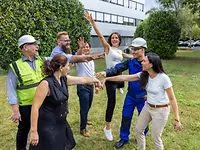As Metallurgical Superintendent, Caelen Anderson supervises a team that is responsible for helping the mine function most efficiently around the clock. “I create value,” is how he first explains his job profile when asked. Although the modern mine around him has nothing more to do with the prospecting romanticism of the Gold Rush, Anderson’s family can still look back on a proud history in this field. His Irish grandfather worked in mining, and the family from Butte, Montana, has spent over 100 years in the industry. He was involved himself in the early planning work for the Haile Gold Mine years before it actually went into operation in 2017. And ANDRITZ was on board as well at that time. “
ANDRITZ has been with us from the very beginning,” he says. “From the start, ANDRITZ and the staff clearly demonstrated their know-how,” Anderson explains and adds that he was especially impressed by the ANDRITZ expertise in the mining sector. And ANDRITZ staff are still on the site regularly, in the meantime there is even a full-time member of staff working entirely on the mine site. “The conditions we had in the beginning at 250 tons per hour (ore feed rate) are different from now, with over 430 tons per hour,” Anderson says.
“The system has grown with us.” Much of Anderson’s work is done in front of computer screens. In a large control room, he discusses mining progress with several colleagues. They are sitting in front of huge monitors watching live camera scenes or computer graphics that show the inside of the rotating mills and what is happening outside on the conveyor belts. A particularly large screen is emblazoned with at least 150 numbers, some are flashing, but only a handful are shown in red. All around, his fellow workers have easily a dozen screens to monitor.
One of these colleagues takes the opportunity to demonstrate some ANDRITZ technologies together with Anderson and Schug. In a small window, the computer shows two values: “SIM Value/Field Value” – where the SIM Value is the value calculated by the new Virtual Instrument tool, based on the Digital Twin technology.
“The system ensures that the processes are predictable and efficient. All this pays off for us,”







